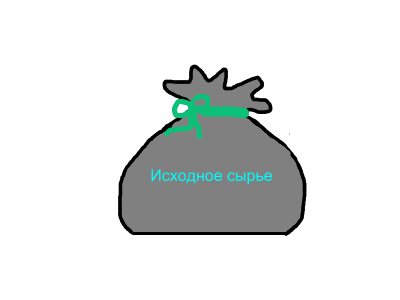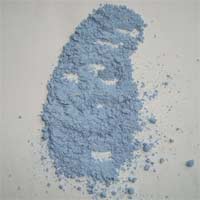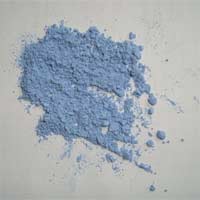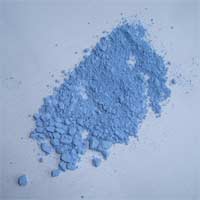

Pigments - a superfine mineral and organic substances with a certain color and insoluble in water, organic solvents and film-forming substances. Mineral pigments, being painted and having a higher refractive index than the film-forming substances (oils, resins, adhesives), provide opacity and color of the coating. In this they differ fundamentally from those of organic dyes [1].
In the Donbas focused enterprise coke, chemical and engineering industries, ferrous metallurgy, and other activities which lead to the deterioration of ecological situation in the region. To date, the waste from those companies are irrationally or throws in the dumps. Therefore, it searches for new ways of utilization of man-made products businesses, which will be claimed.
Currently, there are a number of enterprises, which are used in manufacturing processes polyvalent metals, and waste generators are used very rarely. Since the regeneration of these wastes of metals or metal oxides requires a complex process and is not economically sensible, so it is neutralized, transferred to a less soluble compounds and are disposed in special landfills, thus contributing to environmental pollution.
One way of disposal of wastes containing chromophoric compound is to obtain inorganic pigments. But to use them requires research in the field of technology of inorganic ceramic pigments, the purpose of which - the definition of concentration, mode of synthesis and use in ceramic colors, including the possible simplification and cheapening of production technology. Cost of ceramic pigments is determined primarily by cost of raw materials, especially the coloring oxides. Thus, solving the problem of disposal of anthropogenic wastes containing chromophores, we reduce the cost of paint.
Ceramic dyes should be regarded as a branch of mineral pigments, the results of the synthesis and study of which may be of interest not only to decorate the pottery products, but also for the entire paint industry. In our time developing the production of plastics, products of which begin to displace in many industries, wood, metal, fabric. For plastic products, especially household products, need paint, capable of withstanding temperatures of polymerization in the range 150 - 250 ? C. Under such conditions, aniline dyes are destroyed, the same mineral will remain unchanged. That is what in the world for painting plastics tendency increasing use of inorganic pigments. An obstacle to this application is limited bright colors of mineral pigments, which makes it necessary to conduct research to expand color inorganic pigments.
Fields of application of pigments, as we know, is very broad and diverse: painting aircraft, ships, all kinds of machines, bridges, cars, houses, railway construction, rubber, plastics, and articles of wide application. Pigments used as the basic material painters and decorators, They are the basis of black and color printing, etc.. Pigments also gained importance in several areas of science: in optics, physiology, psychology, ophthalmology, as well as photos and color film [2].
The aim of this work is to study the possibility of obtaining ceramic pigments and paints, using oxides of metals of variable valence.
The work is to obtain ceramic pigments and paints based on them, using man-made products, determining the optimal concentration, temperature, pigment synthesis and consolidation of paint on the product.
The practical value of the work - to the pigments, using as a chromophore of waste products, which have properties that conform to standards. This process is much cheaper cost of such pigments and partially solves the problem of disposal of hazardous waste products.
When the work was the synthesis of ceramic pigments based on mineral diopside (CaO • MgO • 2SiO2).
Diopside is a monoclinic pyroxene mineral with composition MgCaSi2O6. It forms complete solid solution series with hedenbergite (FeCaSi2O6) and augite, and partial solid solutions with orthopyroxene and pigeonite. It forms variably colored, but typically dull green crystals in the monoclinic prismatic class. Diopside is found in ultramafic (kimberlite and peridotite) igneous rocks, and diopside-rich augite is common in mafic rocks, such as olivine basalt and andesite. Diopside is also found in a variety of metamorphic rocks, such as in contact metamorphosed skarns developed from high silica dolomites. It is an important mineral in the Earth's mantle and is common in peridotite xenoliths erupted in kimberlite and alkali basalt. Diopside is a precursor of chrysotile (white asbestos) by hydrothermal alteration and magmatic differentiation; it can react with hydrous solutions of magnesium and chlorine to yield chrysotile by heating at 600oC for three days. Some vermiculite deposits, most notably those in Libby, Montana, are contaminated with chrysotile (as well as other forms of asbestos) that formed from diopside.
At relatively high temperatures, there is a miscibility gap between diopside and pigeonite, and at lower temperatures, between diopside and orthopyroxene. The calcium/(calcium+magnesium+iron) ratio in diopside that formed with one of these other two pyroxenes is particularly sensitive to temperature above 900°C, and compositions of diopside in peridotite xenoliths have been important in reconstructions of temperatures in the Earth's mantle.
Gemstone quality diopside is found in two forms: the black star diopside and the chrome diopside (which includes chromium giving it a rich green colour). At 5.5–6.5 on the Mohs scale, chrome diopside is relatively soft to scratch. Mohs scale of hardness does not measure tensile strength or resistance to fracture.
Diopside based ceramics and glass-ceramics have potential applications in various technological areas. A diopside based glass-ceramic named 'silceram' was produced by scientists from Imperial College, UK during 1980s from blast furnace slag and other waste products. The as produced glass-ceramic is a potential structural material. Similarly, diopside based ceramics and glass-ceramics have potential applications in the field of biomaterials, nuclear waste immobilization and sealing materials in solid oxide fuel cells.
For the synthesis of the pigment used the following raw materials: SiO2 (introduced in the form of sand), MgO, CaO (dolomite, chalk), chromophoric oxide CoO (synthetic material).
The most essential for the paint industry has cobalt. It occurs in the nickel ore, and in addition occurs with arsenic and sulfur in the form of shpeyza and cobalt luster. It is known since ancient times and was found in Egyptian Relmanom glass flux and glass bars Syria and Mycenae. In ancient and medieval art and the Renaissance cobalt as the paint applied. Shmalta applied to the middle of the XVI century, and since that time production started on the Saxon factories fusing safflower, quartz and alkali. Since it is water, lime and oil paint and recently ousted cobalt blue. Currently shmalta used to paint porcelain and faience [4-8].
Cobalt - the substance of the second class of danger (the maximum permissible concentration in air of working area - 0,5 mg / m 3 according to GOST 12.1.005).
Cobalt oxide adversely affects the skin, respiratory tract, the organs of the digestive tract, circulatory, cardiovascular and endocrine systems. Cobalt is one of the substances carcinogenic, fibrogenic, allergens and mutagens and are subject to mandatory recycling of [5].
As the mineralized additives in the synthesis of pigments often use borax, boric acid, salts of alkali metals.
Use of mineralizing can significantly reduce the temperature of the synthesis of pigments [1].
In this paper, ceramic pigment is produced in the following way: the initial raw materials were subjected to grinding in a ceramic mortar manually.
In the synthesis of ceramic pigments in the system diopside is partially replaced by coloring oxide oxides of calcium, magnesium and silicon dioxide. In the course of this work to identify areas in which to carry out studies of pigments synthesis of optimum compositions were synthesized pigments of replacing a certain number of mole on the number of chromophoric oxides.
Raw materials were weighed, respectively recipe, mixed and ground until the passage through the sieve 0063. Pigment charge fired in a laboratory muffle furnace with silicon carbide heating elements. We chose three sintering temperature. Wednesday during firing - oxidizing, at finite temperature roasting pigments withstand 0.5 hours. Burned pigments are sintered aggregates earthy structure of blue with a violet tint. After the dry milling of ceramic pigment grind to pass through a sieve 0056. Finished ceramic pigments packed in plastic bags for clarity, color and quality pigments. Color pigments was assessed visually, according to the catalog chroma (RAV).
For ceramic paint samples in a certain amount in wt.% Was mixed with flux (lead-borate fusible silicate glass), clay, and crushed until passing through a sieve 0056. The mass was transferred to a glass (palette) was added to it as an adhesive additive rosin, turpentine and mastic was ground to a complete homogeneity. The finished paint is applied to a glazed ceramic surface of the samples and allow to dry. Ceramics coated with a paint are fired. Analysis of the calcined product showed that the intensity of blue color of the brush increases with increasing content of cobalt oxide and increasing the temperature of synthesis of pigment.

Similarly were prepared compounds using cobalt oxide contained in the spent alyumokobaltmolibdenovom catalyst. Synthesis of pigments was carried out at the same temperatures. The samples were not aided eye can be distinguished from the corresponding samples synthesized from pure cobalt oxide (II). This is justified by the fact that the composition of the waste contains other chromophores. By the way described above were prepared and painted on pottery, which are then fastened.



Thus, the cobalt contained in waste production, is suitable for the production of ceramic pigments. This solves the problem of partial disposal of man-made products containing polyvalent metals, which reduces the cost of production process of ceramic pigments, paints and reduces human impacts on the environment.



Work continues on the possibility of investigating other chromophores.
Керамические пигменты / И.В Пищ, Г.Н Масленникова. — Минск: Высшая школа, 1987. — 132 с.
Химия и технология пигментов. / И.В. Беленький и др.— Ленинград: Государственное Научно — Техническое издательство химической литературы, 1960. — 756 с.
Материал из Википедии [Электронный ресурс]. – Режим доступа: www/URL: http://ru.wikipedia.org/wiki/%D0%94%D0%B8%D0%BE%D0%BF%D1%81%D0%B8%D0%B4
Красочные пигменты / Г.Вагнер; Под ред. Е.Ф. Беленького, Е.С. Тихонова, Н.А. Толмачева. — Л.: Высшая школа, 1935.
Сборник санитарно-гигиенических нормативов и методов контроля вредных веществ в объектах окружающей среды. — М., 1991. - 22с.
Производство пигментов (современное состояние и тенденции развития)/ Под ред. И.Н.Сапгир. – М: Химия, 1958. – 48с.
Штейнберг Ю.Г. Тюрн Э.Ю. Стекловидные покрытия для керамики. - Ленинград: Стройиздат, 1989. - 192с.
Пигменты (Введение в физическую химию пигментов)/ Под ред. Д.Паттерсона. – Ленинград: Химия, 1971. – 176с.
Будников, П.П. Химическая технология керамики и огнеупоров. – М.: Издательство литературы по строительству, 1972. – 552с.
Химическая технология стекла и ситаллов/ Под ред. Н.М. Павлушкина. – М.: Стройиздат, 1983. – 432с.